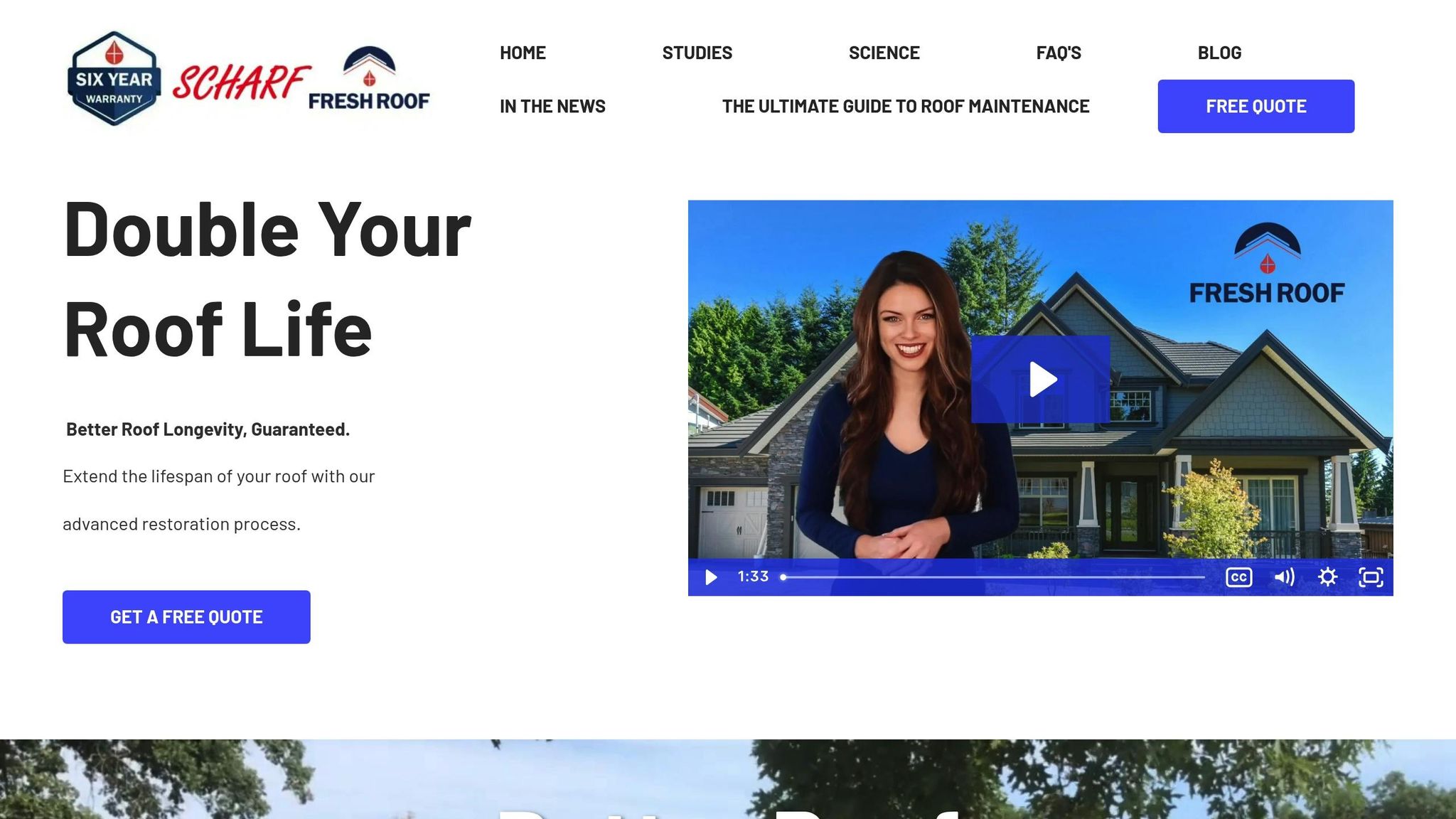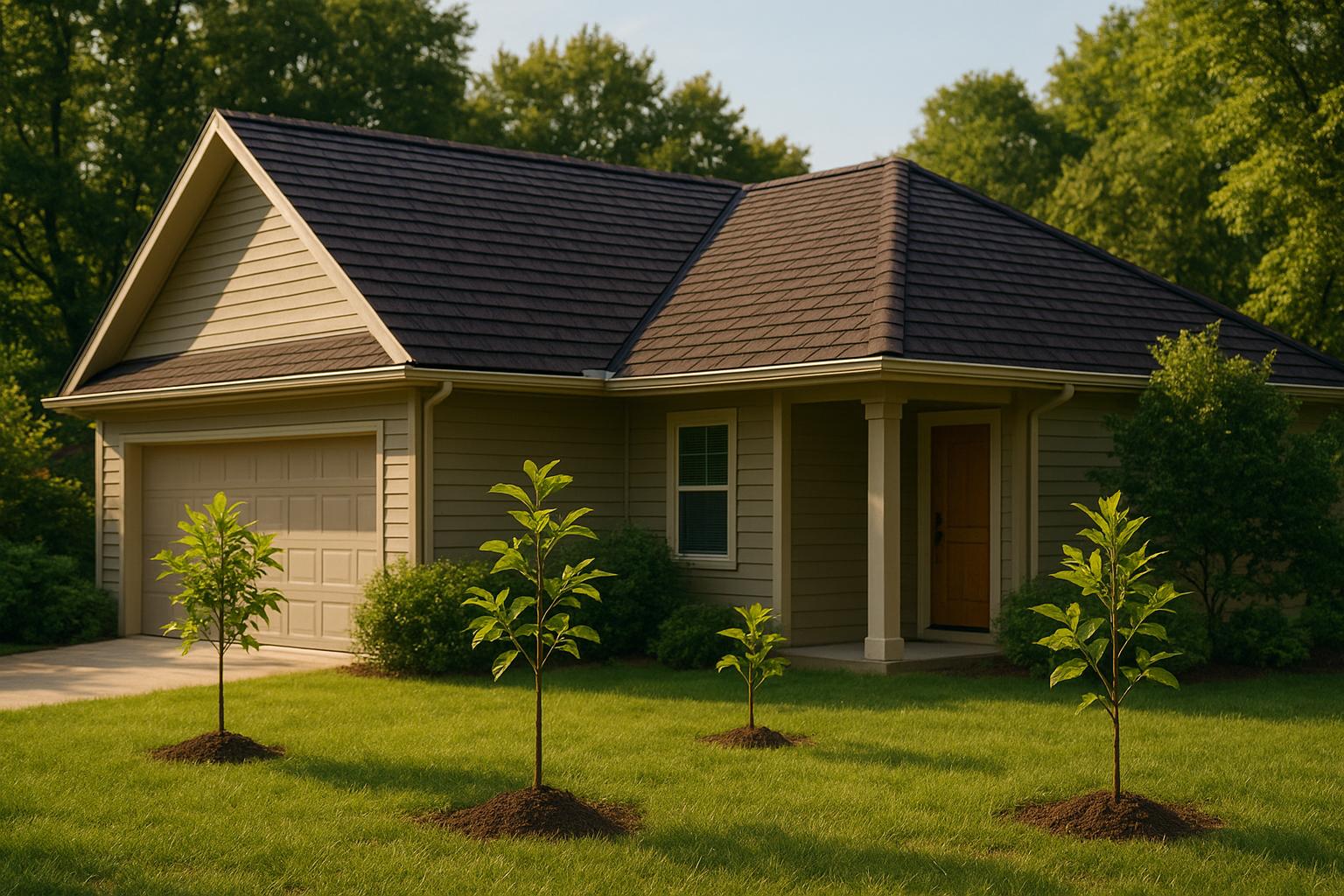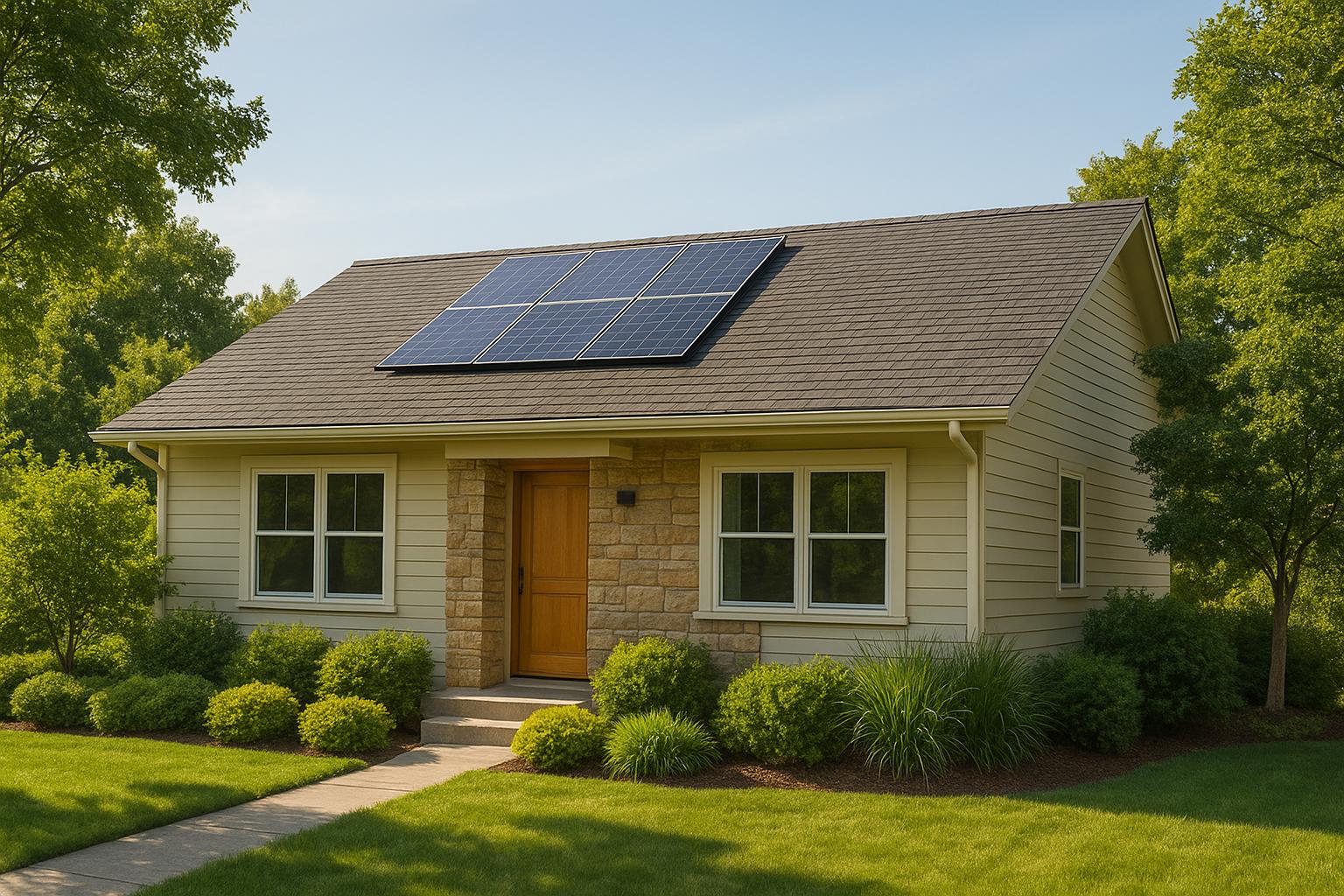Roof moisture barriers are critical for protecting your home from water damage by preventing leaks and maintaining the integrity of your roof structure. Over time, these barriers can weaken due to weather, aging, and wear, leading to costly issues like rot and mold. Reinforcing them is a cost-effective way to extend your roof's lifespan and improve energy efficiency.
Key Steps to Reinforce Roof Moisture Barriers:
- Inspect and Prepare: Remove old materials, clean the roof deck, and replace damaged areas.
- Choose Materials: Use synthetic underlayment, vapor barriers, sealants, and durable fasteners.
- Install Properly: Start at the roof's edge, overlap sections, and seal around vents and chimneys.
- Check and Maintain: Inspect twice a year and repair minor issues immediately.
For complex issues or long-term solutions, professional services like Scharf Fresh Roof offer advanced treatments and warranties to ensure lasting protection.
How To Install Roofing Underlayment
Materials and Tools You'll Need
Getting organized before starting is key to a smooth and efficient process. Begin by gathering all the necessary materials and tools.
Materials for Moisture Barriers
The foundation of effective reinforcement lies in choosing the right materials.
- Durable synthetic underlayment: This is a go-to option for many homeowners due to its strength and resistance to tears. Unlike traditional felt paper, it can handle foot traffic during installation without damage.
- Polyethylene (PE) vapor barriers: These plastic-based barriers are excellent for controlling humidity. Available in various thicknesses, they are classified as Class I barriers, meaning they are highly resistant to moisture.
- Bituminous vapor barriers: Ideal for challenging applications, these barriers are made from bitumen and often come with a self-adhering backing for easier installation. They’re especially effective on flat roof sections and bond well with different roofing materials.
- Sealants: Use polyurethane or silicone sealants to secure joints around roof penetrations. Polyurethane options are flexible and adapt to your roof’s natural expansion and contraction, while silicone caulks are excellent for sealing around vents and chimneys.
- Fasteners: Galvanized or cap fasteners are recommended for their durability in harsh weather. Cap fasteners, in particular, provide better wind resistance compared to standard nails, making them a strong choice for storm-prone areas.
Once your materials are ready, it’s time to gather the tools you'll need for the job.
Tools for Installation
Having the right tools ensures a safer and more efficient installation.
- Utility knife: A sharp utility knife is essential for making clean cuts in underlayment materials. Dull blades can tear the material and create weak points.
- Measuring tools: A 25-foot tape measure is perfect for most residential roof measurements, while a chalk line helps maintain straight and properly aligned underlayment rows.
- Safety gear: Prioritize safety by using a harness, sturdy ladder, slip-resistant shoes, gloves, safety glasses, and a dust mask.
- Fastening tools: For securing materials, you’ll need a hammer for roofing nails or a pneumatic nailer for larger areas. Cap fasteners are generally more secure than staples, though some synthetic underlayments do allow staples. Space fasteners about 6 inches apart along edges and 12 inches in the center to prevent wind uplift.
- Caulking gun: This tool is crucial for sealing gaps around roof penetrations and plate connections.
- Additional tools: A putty knife or screwdriver is useful for working barrier material into tight spaces around vents, chimneys, and other features. Scissors or heavy-duty shears are great for cutting thicker materials or when you need more control than a utility knife provides.
Using sharp and appropriate tools ensures clean edges that seal properly, making the installation both effective and long-lasting.
How to Reinforce Your Roof Moisture Barriers
When you're set with the right materials and tools, follow these steps to build a dependable moisture barrier for your roof.
Inspect and Prepare the Roof
Getting your roof ready is the cornerstone of a successful moisture barrier installation. Start by removing any existing roofing materials to expose the roof deck. This step is crucial - it allows you to thoroughly check the condition of the roof structure and ensures the new barrier will adhere properly.
After stripping the old materials, clean the deck by sweeping away dirt and debris. It's important that the surface is completely clean and dry before moving forward. While you're at it, examine the decking for any signs of damage, like rotted or weakened boards, and replace them if needed. This ensures you’re working with a solid base. Check that the roof decking meets building codes, such as using 3/8-inch plywood or 7/16-inch OSB with gaps no larger than 1/4 inch, to catch any hidden water damage.
Once the deck is clean, inspected, and repaired, you're ready to start installing the barrier.
Install the Moisture Barrier
With the roof deck prepped, it’s time to install the barrier. Follow the manufacturer’s instructions carefully to ensure long-lasting protection. Begin at the lowest edge of the roof and work your way upward, overlapping each section as recommended. If you're using a self-adhering membrane, peel back the protective backing gradually and press it down firmly to remove any trapped air.
For areas around roof penetrations, like vents or chimneys, trim the barrier to fit snugly and seal it tightly to prevent leaks. This overlapping and sealing method addresses the natural gaps that exist in asphalt shingles.
As Joe McAuley, a former engineering and technical expert, puts it:
"Shingles are not 100% moisture-proof because they are applied in pieces that have air gaps. So, the roof deck will last longer by having a layer of roofing felt (tarpaper) over it before adding shingles."
– Joe McAuley, Former Various Engineering/Technical at Ball Bros. Research Corp., Miles Laboratories, Western Elec., IBM
Once the barrier is in place, double-check every seam and detail to ensure everything is secure.
Check Your Work and Finish
Go over all seams and overlaps to confirm they are properly sealed according to the product's instructions. For instance, if you're using a product like WeatherLock® Flex, remember that primer is not required for the deck.
When all seams are sealed and secure, your reinforced moisture barrier is complete, providing your roof with a layer of extra protection.
sbb-itb-b7819d6
Maintaining Your Moisture Barriers
Taking care of your roof's moisture barriers is key to keeping your home protected from water damage.
Regular Roof Inspections
Plan to inspect your roof twice a year - once in the spring and again in the fall. It's also a good idea to check after any severe weather event, like a heavy storm or hail.
During these inspections, look closely for signs of wear and tear. Keep an eye out for bubbling, water stains, or lifted edges, particularly around vents, chimneys, and skylights. Pay extra attention to spots where different roofing materials meet, as these areas are more prone to gaps. Don’t forget to check your gutters and downspouts for debris - clogged gutters can force water underneath your shingles, leading to bigger problems.
Catching these issues early makes repairs much easier and less costly.
Making Small Repairs
Address minor problems as soon as you notice them to avoid larger, more expensive damage. For small punctures or tears, you can clean the area thoroughly and apply a patch following the manufacturer's instructions. If you spot loose flashing around roof features like chimneys or vents, reattach and reseal it right away using a sealant suited to your roofing material. However, if you’re dealing with multiple issues or something beyond your expertise, it’s best to call in a professional.
Keeping a maintenance log is a smart move. Record your inspection dates, any problems you find, and the repairs you make. This not only helps you monitor your roof's condition but also provides helpful details if you ever need professional help.
Professional Solutions with Scharf Fresh Roof

Once you've explored DIY methods, it’s worth considering professional services for tackling more complex roofing challenges. While DIY moisture barrier reinforcement is great for routine upkeep, professional roof restoration dives deeper, addressing the overall health of your roofing system. Scharf Fresh Roof combines advanced technology and expert craftsmanship to enhance not just the moisture barriers but the entire roof. Let’s break down what makes their services stand out.
Benefits of Scharf Fresh Roof Services
Scharf Fresh Roof employs its patented GreenSoy Technology to breathe new life into asphalt shingles. This plant-based, eco-conscious formula is the result of rigorous scientific development and delivers a more durable and flexible roof. Unlike DIY solutions, this professional-grade treatment works at the molecular level, reversing the effects of aging and oxidation in asphalt shingles. The result? Restored flexibility and strength that improve your roof’s overall sealing ability.
The financial upside is undeniable. Instead of shelling out for a full roof replacement, homeowners can save thousands of dollars while still benefiting from a transferable warranty. This warranty not only protects your investment but also adds long-term value to your property.
Scharf Fresh Roof also underscores its commitment to sustainability by planting a tree for every roof treated. This initiative aligns perfectly with the eco-friendly ethos of their GreenSoy Technology, making it a win for both your home and the planet.
Why Use Professional Services
Professional services go beyond just applying treatments - they ensure your roof is restored with precision and care. Scharf Fresh Roof technicians are trained to seamlessly integrate moisture barrier reinforcements with advanced restoration techniques like GreenSoy Technology.
But their expertise doesn’t stop there. These professionals are skilled at detecting and addressing underlying issues that could compromise your roof’s integrity. Whether it’s structural concerns, poor ventilation, or hidden damage, they tackle the root causes to ensure your roof remains protected for the long haul. This comprehensive approach ensures a level of durability and reliability that DIY methods simply can’t match.
Conclusion
Taking the time to install and maintain a moisture barrier properly is key to keeping your roof in great shape for the long haul. When reinforced correctly, it helps prevent expensive water damage and stands out as one of the best investments for safeguarding your home.
While DIY methods might seem like a cost-effective solution, they come with potential risks. Errors such as improper overlapping, weak fastening, or failing to follow specific instructions can significantly reduce the barrier’s effectiveness and may even void warranties.
On the other hand, hiring a professional ensures peace of mind and reliable results. As T. Simpson Roofing Ltd explains, "By having your underlayment installed with a certified professional, you and your family can rest assured that your roof will remain strong and reliable for many years to come". Similarly, Tag & Stick emphasizes, "Professional workmanship is a must for a high-quality underlayment job to be a success".
Investing in expert installation not only enhances the durability of your roof but also ensures it stands up to the test of time.
FAQs
What are the signs that my roof's moisture barrier needs reinforcement?
If your roof's moisture barrier is struggling, you might spot water stains on your ceilings or walls - clear signs that water is sneaking through. Shingles that peel or lift are another red flag, hinting at a problem with the underlayment or moisture barrier. You should also keep an eye out for buckling shingles, a sagging roof deck, or even sunlight peeking through the roof boards.
Taking care of these problems quickly can save you from bigger headaches and expensive repairs down the line. If you're not sure about the state of your roof, it’s a good idea to have a professional take a look to keep your home safe and sound.
What’s the difference between synthetic underlayment and bituminous vapor barriers for roofing?
When deciding between synthetic underlayment and bituminous vapor barriers, it's essential to consider your roof's specific requirements and the local environmental conditions.
Synthetic underlayments are known for being lightweight, durable, and highly resistant to water. They’re simple to install and hold up well even with extended UV exposure, which makes them a common choice for asphalt shingle roofs. In contrast, bituminous vapor barriers excel at blocking moisture vapor, making them ideal for regions with high humidity or roofs with inadequate attic ventilation.
If your primary concern is reinforcing the roof's moisture barrier, synthetic underlayments are often the go-to due to their strength and convenience. However, if preventing vapor buildup is more critical, bituminous barriers could be the better fit. Always factor in your climate and roof design when making your choice.
Why should I choose professional services like Scharf Fresh Roof for reinforcing roof moisture barriers instead of doing it myself?
When you choose professional services like Scharf Fresh Roof, you're ensuring that your roof's moisture barriers are strengthened with skill and attention to detail. Experts rely on top-tier materials and trusted methods to deliver strong protection against moisture, which can significantly increase your roof's durability.
Another key advantage of hiring professionals is the added benefit of warranties and ongoing support. These services not only provide peace of mind but also help protect your investment in the long run. Unlike DIY approaches, which can sometimes result in mistakes or inadequate coverage, professional solutions offer a level of reliability and cost efficiency that's hard to match.

